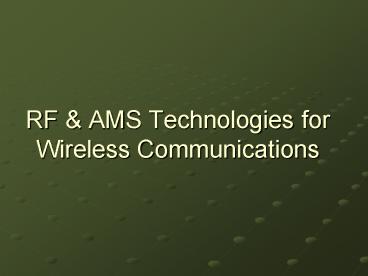RF - PowerPoint PPT Presentation
Title:
RF
Description:
RF & AMS Technologies for Wireless Communications. Introduction ... Two or more technologies coexist with one another for following applications ... – PowerPoint PPT presentation
Number of Views:52
Avg rating:3.0/5.0
Title: RF
1
RF AMS Technologies for Wireless Communications
2
Introduction
- Present the challenges of RF and AMS technology
for wireless applications operating between .8
GHz 100 GHz in - Cellular Phones
- Wireless LAN
- Wireless personal area network
- Phased array RF systems
- And other wireless applications
3
Current Area of Research
- Frequency (RF) region between 10 GHz 40 GHz is
the region where competition is - Group IV semiconductors (Si SiGe) dominate
below 10 GHz - Group III-V semiconductors dominate above 40 GHz
4
Why the Gap?
- SiGe can operate between 10-40 Gbits range
- However, it does not perform well when either
high power gain or ultra low noise is required - SiGe and GaAs is currently being used between 10
GHz 40 GHz - These are WLAN, Satellite TV, UWB, LMDS
5
Performance
- Performance increases in following order Si
CMOS, SiGe, GaAs, InP metamorphic - Two or more technologies coexist with one another
for following applications - Cellular transceivers, modules for terminal power
amplifiers, millimeter wave receivers
6
Current trends
- BiCMOS is mostly used in cellular transceivers in
place of CMOS - GaAs HBT and LDMOS devices are used in modules
for terminal power amplifiers - GaAs PHEMT and InP HEMT is used in mm-wave
receivers
7
Important parameters for Wireless Systems
- Cost
- Available frequency band
- Power consumption
- Functionality
- Size of mobile units
- Appropriate performance requirements
- Protocols Standards
- Operating Frequencies, channel bandwidth and power
8
How to increase RF performance?
- For silicon by geometrical scaling
- For III-V compound semiconductors by optimizing
carrier transport properties through materials
and bandgap engineering
9
Four Distinct Wireless system building blocks
- Analog/mixed-signal (Nick)
- RF Transceivers (Nick)
- Power amplifiers Power management
- Millimeter Wave
10
Power Amplifiers and Power Management
- High voltage devices are used in base station
power amplifiers such as - Si LDMOS, GaAs FET, GaAs PHEMT,
- SiC Fet, GaN FET
- Migrating away from packaged single die with
RFICs to multi-band multi-mode integrated modules
deliver a complete amplifier solution
11
Power Amplifiers and Power Management
- These modules integrate most of the matching and
bypassing networks and provide power detection,
power management, filtering and RF switches for
both transmit/receive and band selection - Signal isolation becomes difficult due to high RF
voltage created by the power amplifiers and power
management circuit, and internally generated
frequencies which prevents full SOC implementation
12
Millimeter Wave
- Compound semiconductors dominate the 10-100 GHz
range - HEMT, PHEMT, and MHEMT are used for analog
mm-wave applications - Great diversity in the nature and performance of
these devices due to selection of materials,
thickness and doping in the stack
13
Millimeter Wave
- Performance trends driven by bandgap engineering
of the epitaxial layer stack in concern with
shrinking lithography - Major performance metrics noise, power,
efficiency, breakdown and lithography dimensions - This sub-section has greatest diversity in
combinations of materials, device types,
applications and performance
14
Millimeter Wave
- Six-inch GaAs wafers are becoming de facto
standard - GaAs tends to be two generations behind Si in
wafer size - Thermal dissipation for high power III-V devices
is one of the critical challenges, especially
true for high-power density devices such as GaN
15
- Questions?































